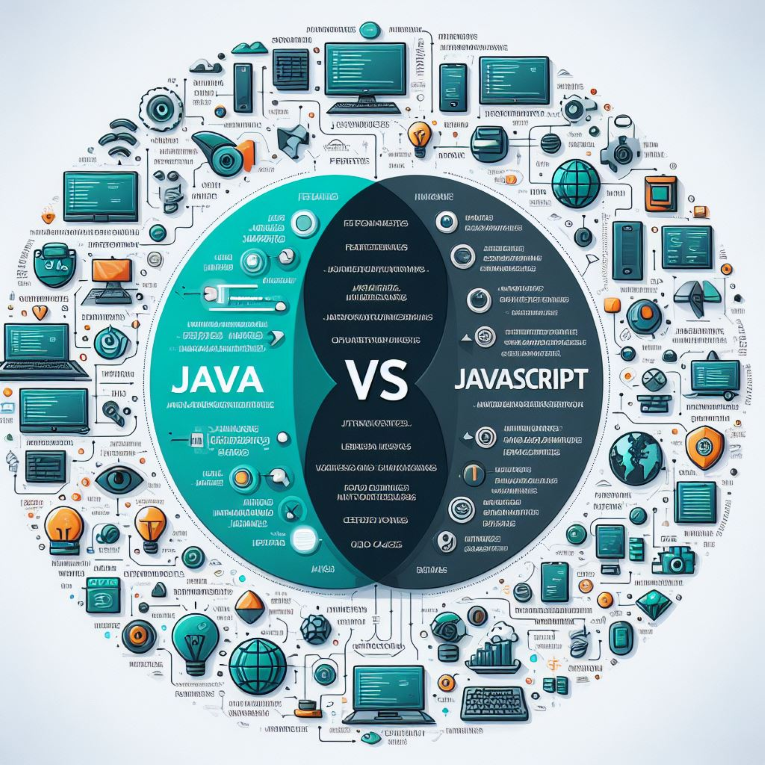Last updated on August 16th, 2024 at 09:45 pm
Although Java and JavaScript appear to be the same computer language under different names, they are actually distinct from one another. This article compares and contrasts Java Vs. JavaScript, elucidating the distinctions, uses, and applications of both widely used programming languages.
Knowing the distinction between Java and Javascript in the world of programming languages will help you select the best one for your job. Java is widely utilized for backend development at the enterprise level, and JavaScript is used to create interactive websites.
Java is a computer language used for server-side or backend development that incorporates the idea of object-oriented programming. JavaScript, on the other hand, is a lightweight programming language that is used to create web technologies through scripting.
The fundamentals, features, uses, and parallels between Java and JavaScript will now be covered.
What Is Java?
Java is a compiled, object-oriented programming language that James Gosling created at Sun Microsystems in the middle of the 1990s. Its powerful applications and platform independence are built into its architecture. The original motto of Java was “Write Once, Run Anywhere.”
The creation of server-side apps, enterprise apps, Android apps, and more are a few of the widely used Java applications. Although Java was initially intended to be used for interactive television, its cross-platform compatibility and robustness make it the go-to language for designing enterprise-level applications.
Check Also – Best Java Courses for Beginners
What Is JavaScript?
JavaScript is a lightweight interpreted programming language that enhances static HTML pages and may be used to create interactive websites, unlike Java. Developed in 1995 by Brendan Eich at Netscape Communications Corporation, this language improves user experience by interacting with the online browser.
Front-end web development, which includes dynamic content creation, form validation, DOM manipulation, etc., is the main use case for JavaScript. Javascript is also useful for server-side development when used with JavaScript engines such as Node.js.
Check Also – Best JavaScript Courses for Beginners
Java Vs. Javascript: Features of Java

Java is a popular programming language that is both versatile and widely used. Its prominence is attributed to several key qualities. Now let’s explore these features:
Simple
The simple syntax of Java makes it simple to learn and comprehend. Explicit pointers and operator overloading, two intricate and little-used features, have been eliminated. Memory management is also made easier by the automatic garbage collection.
Object-Oriented
Java treats everything as an object. Software development and maintenance are improved by the concepts of object-oriented programming (OOPs), which include inheritance, polymorphism, abstraction, and encapsulation.
Platform Independent
Java adheres to the principle of “Write Once, Run Anywhere.” Code is compiled into bytecode so that it may run on different operating systems (Windows, Linux, macOS, etc.).
Portable
Java’s platform independence contributes to its portability. By running bytecode in a variety of settings, the Java Virtual Machine (JVM) facilitates execution.
Robust
Java places a heavy emphasis on handling errors and memory management. To make it more robust, it has features like exception handling and automatic garbage collection.
Java is dependable and error-free due to its robustness.
Secured
For the following reasons, Java is well-known for its security.
- Memory corruption cannot be avoided using explicit pointers.
- To guarantee code integrity, use the bytecode verifier.
- By isolating local and network-based classes, classloaders improve security.
Multithreaded
Java has multithreading capabilities, which enables applications to run numerous processes at once.
Distributed
The ability to construct distributed applications is one of Java’s other features. Remote Method Invocation and Enterprise Java Beans can be used to create this. Java’s ability to call methods from any internet-connected machine is made possible via this capability.
An example of a Java Program
Here’s a simple Java “Hello, World!” program that prints the famous phrase to the console:
public class HelloWorld {
public static void main(String[] args) {
System.out.println(“Hello, World!“);
}
}
This program defines a class called HelloWorld.
The program is executed from the main() method.
To print the string “Hello, World!” to the standard output (your screen), we use System.out.println(“Hello, World!”); inside the main() method.
When you run this program, it will display:
Hello, World!
Java Vs. Javascript: Features of JavaScript

JavaScript is a versatile language with several key features. Let’s explore them –
Script Language with an Object-Oriented
With its built-in objects, JavaScript is object-oriented. For example, the window object offers access to browser functions and features.
Cutting-Edge Technologies
JavaScript is mostly used to improve user interactions on websites on the client side. It makes it possible to validate dynamic behavior and user input.
Verification of User Data Entry
JavaScript verifies the validity of data entered into HTML forms before delivering it to the server. Maintaining data integrity is aided by this validation.
If and Else Clauses
Conditional expressions like if, else, and else if are supported in JavaScript. These enable decision-making in accordance with particular criteria.
Interpreter-focused
Since JavaScript is an interpreted language and is run by the browser immediately, there is no need for compilation.
Built-In Features
A wide range of built-in functions for operations like manipulating dates, texts, and arrays are available in JavaScript.
Sensitive and Lightweight Remarks
JavaScript code runs quickly and is lightweight. It works great for developing websites.
Looping and Managing Events
Loops (while and for) are supported in JavaScript to handle repetitive operations. Interaction with user activities (such as button clicks) is made possible by event handling.
Inheritance Based on Prototypes
Prototypes are used by JavaScript for object inheritance. Prototypes give methods and properties to objects via inheritance.
Platform-Independent
JavaScript is platform-independent and works with a variety of browsers and platforms. It isn’t dependent on any one operating system.
Dynamic Typing
Variables in JavaScript are dynamically typed. During runtime, multiple data types can be assigned to the same variable.
Functional Style
Paradigmas of functional programming are supported by JavaScript. Higher-order functions and closures are permitted because functions are first-class citizens.
Single-Threaded
Single-Threaded JavaScript runs in the browser on a single thread. Callbacks or Promises are used in asynchronous processes, such as AJAX requests.
Improving Online User Interfaces
JavaScript manipulates HTML elements to enable interactive online interfaces. It includes responsive behavior, dynamic content, and animations.
Used by Major Web Giants
Major Web Giants Use JavaScript: JavaScript is used by websites like Google Maps, Gmail, YouTube, Facebook, and Twitter.
An example of a JavaScript Program
Using javascript approaches, as opposed to Java, you can write a Hello World application in just one line.
Three distinct approaches to writing a JavaScript “Hello, World!” program are as follows:
1. Using console.log()
For troubleshooting and printing messages to the browser console, the console.log() method is frequently utilized.
In the developer console of the browser, it shows the designated message.
Example –
console.log(“Hello, World!”);
2. Using document.write()
The HTML document is directly updated with content via the document.write() method.
It helps with dynamic text addition to web pages.
Example:
document.write(“Hello, World!”);
3. Using alert()
An alert box with the chosen message is displayed using the alert() method.
The browser will display a pop-up alert when you execute this code.
Example:
alert(“Hello, World!”);
Feel free to select the approach that best meets your requirements!
Java Vs. Javascript: What Are The Applications of Java?

Java is a computer language that is quite versatile and is used in many different fields. Let’s examine a few of its primary uses:
Desktop GUI Applications
Java is a great option for developing graphical user interface (GUI) desktop applications. Developers can create cutting-edge, aesthetically pleasing desktop applications with the use of APIs like JavaFX, Swing, and Abstract Windowing Toolkit (AWT). Features like visual feedback, ease of learning, and simultaneous display of several instances are advantageous for these applications.
Mobile Applications
Developed for smartphones and other small-screen devices, Java is a cross-platform foundation for mobile applications. Remarkably, it’s the second most popular language for creating mobile apps. Java is used to create well-known smartphone apps like Spotify, Netflix, Uber, Signal, Minecraft, and Twitter.
This programming language is a great option for developing mobile applications because of its robust security features, superior cross-platform capability, ease of code creation, and high compatibility with Kotlin.
Artificial Intelligence (AI)
Java works great for applications involving AI. Its infrastructure improves AI programming by integrating with intelligent applications in a seamless manner. Java is a great option for AI development because of its standard widget tools, simplicity of debugging, and improved user interaction.
Web Applications
Java works great for applications involving AI. Its infrastructure improves AI programming by integrating with intelligent applications in a seamless manner. Java is a great option for AI development because of its standard widget tools, simplicity of debugging, and improved user interaction.
Big Data Technologies
Big data processing requires the use of Java extensively. Java is essential to the distributed computing capabilities of technologies such as Hadoop, Spark, and Flink. Because of its stability, scalability, and efficiency, it is a favored language for working with large data collections.
Distributed Applications
Building distributed applications is a good fit for Java because of its network-centric capabilities and independence from other platforms. These programs can function flawlessly on many computers linked by networks.
Cloud-based Applications
Cloud computing makes extensive use of Java. Java-based services are provided by platforms such as Amazon Web Services (AWS) and Google Cloud Platform (GCP). With Java, developers may create dependable and scalable cloud apps.
Keep in mind that Java has an impact that goes beyond these instances. It can be found in a variety of sectors, including IoT and enterprise applications. Java remains a preferred choice for developers globally, even as technology advances.
Java Vs. Javascript: Top Applications of JavaScript

After understanding the applications of java, the next is to know the top usages of javascript. JavaScript is a versatile programming language with a wide range of applications. Let’s explore some of the practical uses of JavaScript:
Web Development
Web development, whether front-end or back-end, requires JavaScript. A web page’s structure is provided by HTML, its style is applied by CSS, and its functionality is dynamically updated by JavaScript.
There are two methods for adding JavaScript to an HTML file:
- Internally: Through the HTML file’s <script> elements, which have JavaScript code embedded within.
- Externally: Via the <script> tag, which links an external JavaScript file.
Server-Side Applications
These days, JavaScript isn’t just for browsers. Server-side scripting is a common use for it. Writers may use JavaScript to write server-side code thanks to technologies like Node.js.
Game Development
When making browser-based games, JavaScript is a frequently used option. For 2D and 3D game development, game engines such as Phaser and Three.js use JavaScript.
Mobile Apps
JavaScript can be used by developers to create cross-platform mobile apps with frameworks such as React Native and Ionic. Both iOS and Android smartphones can use these apps.
Web Apps
A lot of web apps that offer dynamic and interactive user experiences are powered by JavaScript.
Efficient web app development is made possible by frameworks such as Angular, Vue.js, and React.
Browser Extensions
The functionality of web browsers is improved via browser extensions. The main language used to create extensions that alter browser behavior is JavaScript.
Productivity Apps
Many productivity products, including web-based office apps and Google Workspace (previously G Suite), require JavaScript.
3D Graphics and Animation
With libraries such as Three.js, developers can produce beautiful 3D images and animations from within the browser.
Internet of Things (IoT)
In Internet of Things devices, JavaScript is used to facilitate communication between web services and hardware.
Robotics
JavaScript has uses in robotics since it can automate processes and control robots.
Keep in mind that a solid understanding of JavaScript leads to fascinating chances in the technology sector. JavaScript is still an effective tool whether you’re creating mobile apps, websites, or researching cutting-edge technology!
Java Vs. Javascript: Development Environment
Java Compilation And Execution Process
Now, let’s talk about the step-by-step instructions for writing, compiling, and running a Java application. Compilation and execution are the two main processes in this process.
Compilation Process
Writing Java Code
Initially, you utilize a text editor (like Notepad or any other code editor) to write your Java code. A file with the .java extension contains this code.
The Java compiler (javac) processes your .java file.
It performs several essential steps:
Step 1: Parse: Generates an Abstract Syntax Tree (AST) by reading the Java source files.
Step 2: Enter: Updates the symbol table with new symbols (for example, class names, variables, and methods).
Step 3: Process Annotations: Annotations identified in the compilation units are processed upon request.
Step 4: Attribute: Handle type checking, name resolution, and continuous folding.
Step 5: Flow: Evaluates the flow of data, making sure to verify reachability and assignments.
Step 6: Desugar: Takes off some syntactic sugar and rewrites the AST.
Step 7: Generate: Creates bytecode-containing .class files for every class in your source file.
Execution Process
The produced class files are independent after compilation and can operate on any hardware or operating system. In the three steps of the execution process—class loader, bytecode verifier, and just-in-time compiler—the main class file is executed. Let’s talk about these stages immediately.
1st Stage: Class Loader
By reading its .class file, the Class Loader loads the main class—the one with the main method—into memory. The class loader loads additional referenced classes as well.
An object that creates a flat namespace of classes and refers to them as strings is called a class loader.
Class loaders come in two varieties.
Primordial: Integrated into every JVM, it functions as the standard class loader.
Non-primordial: Class loaders that may be user-defined to alter the way classes are loaded.
2nd Stage: Bytecode Verifier
A class’s bytecode is loaded and then examined by the Bytecode Verifier. Its responsibility is to make sure that the commands are accurate, conduct no unwanted behaviors, and don’t go against security restrictions.
3rd Stage: Just-In-Time (JIT) Compilation
Just-In-Time (JIT) compilation, the last step of the JVM, transforms the bytecode into machine code. This dynamic procedure takes place in the midst of the execution phase.
JIT Compiler’s duties also include optimizing the bytecode for certain hardware and operating systems. Ultimately, the CPU processes the machine code that was generated.
The two steps in the Java execution process are compilation to bytecode and then execution on the Java Virtual Machine (JVM). Java programs can execute on any machine, regardless of the underlying architecture, by following these instructions. Check out this reference to find out more information about this.
Java Vs. Javascript: Key Differences Between Java And Javascript

Up till now, you’ve gained a greater understanding of Java and JavaScript, as well as the concepts behind both languages. Here, we’ve outlined some of the most important distinctions between Java and JavaScript to provide you a brief rundown.
| Java | JavaScript | |
| Language Type | Because Java is a compiled language, the code is first translated to machine code by the compiler before it is executed. | JavaScript is an interpreted language. It runs directly in the browser without compilation. |
| Typing | The language is statically typed. Before being used, variables need to have their data types specified. | The language is dynamically typed. Types of variables are decided upon during runtime. |
| Purpose | Mostly utilized for compiling programs that are platform-neutral. Cross-platform app development and Android development are its main uses. | Utilized to add interactivity to websites. It is frequently used in web development and allows dynamic material to be inserted into HTML. |
| Syntax and Usage | Possesses object-oriented concepts and a syntax akin to C. In addition to classifying programs, it highlights ideas like inheritance, polymorphism, abstraction, and encapsulation. | It’s unrelated to Java, yet it also features a syntax similar to C. Its original purpose was to manipulate the DOM and generate dynamic websites. |
| Syntax and Usage | Makes the claim, “Write Once, Run Anywhere.” It creates bytecode from source code that may execute on any platform by using a Java Virtual Machine (JVM). | Primarily runs in web browsers, making it platform-dependent for client-side scripting. |
| Robustness and Error Handling | Makes an attempt to identify errors early on. Numerous mistakes that other languages might overlook are caught by the Java compiler. | Lenient error handling; certain problems might only manifest in runtime. |
| Security | In the absence of pointers, out-of-bound array access is prevented. It’s thought to be more safe. | More vulnerable due to its dynamic nature. |
Java Vs. Javascript: Similarities
This section explores some of the main similarities between Java and JavaScript.
Object-Oriented Paradigm
Object-oriented programming is supported by both Java and JavaScript.
Their focus lies in organizing code through the use of classes and objects.
Web Development Usage
Web development makes extensive use of both languages.
Java is utilized for programming on the server side, and JavaScript is mainly used for client-side scripting on web browsers.
Cross-Platform Execution
Write Once, Run Anywhere is a concept that Java (and the Java Virtual Machine) support.
JavaScript has the versatility to run on multiple platforms, including browsers.
Libraries and Frameworks
A robust ecosystem of frameworks and libraries supports both languages.
These technologies help developers run programs more effectively and increase productivity.
Syntax Elements
Curly Braces: Both Java and JavaScript use { and } as code block delimiters.
Semicolons: Both languages end statements with semicolons (;).
Math Library: They both provide a Math library (e.g., Math.pow).
Syntax Basics
Both languages have common structures such as operators (+, -, *, /), conditionals (if, else), and loops (for, while). This is because they employ C-style syntax.
Garbage Collection
Garbage collection is used automatically by both languages to manage memory.
When an object in Java is no longer referenced, it immediately gets deallocated.
Memory management in JavaScript is handled by the browser’s JavaScript engine.
Standard Libraries
Both come with sizable standard libraries that include pre-built classes and functions.
Packages like java.util, java.io, and java.lang are part of the Java standard library.
The standard library of JavaScript contains functions for working with dates, arrays, and strings.
Community and Ecosystem
There are thriving ecosystems and active communities for both languages.
Developers build libraries, exchange information, and contribute to open-source projects.
Programmers working in either language benefit from this collaborative environment.
Java Vs. Javascript: Learning Curve
Java can have a steep learning curve at first, especially for people who are not experienced programmers. But with perseverance and practice, it gets easier to handle.
Learning Java can seem more difficult because of its rigid syntax and many guiding concepts. The fundamentals, syntax, object-oriented programming concepts, libraries, frameworks, memory management, and more complex subjects like networking and multithreading will all need to be learned.
However, because of its modest grammar and flexibility, JavaScript is easier to learn than Java. JavaScript code is simpler to understand than Java because of its dynamically typed architecture.
Job Opportunities for Java Students
There are many fascinating employment options available to you if you’re a Java fan. Now, let’s explore the best Java career options, including their main responsibilities and typical pay.
Web Developer
Web developers use HTML, CSS, JavaScript, and Java principles to optimize users’ experiences on websites. They oversee feature updates, product launches, and website enhancements.
Average Salary: ₹9,00,000 per year.
Computer Programmer
Computer programmers create and manage code, as well as test software, record findings, and fix bugs in the code. They work together with software engineers to create cutting-edge apps.
Average Salary: ₹13,00,000 per year.
Junior Java Developer
Junior Java developers are in charge of data management, server-side logic, and back-end development. They establish a connection between online services and applications.
Average Salary: ₹3,06,176 per year.
Software Engineer
Java is used by software engineers to design, create, and maintain software programs. They guarantee software scalability, produce clean code, and work with cross-functional teams.
Average Salary: ₹9,00,000 per year.
Android Developer
Android developers use Kotlin and Java to create mobile applications for Android devices. They concentrate on app performance, data storage, and user interfaces.
Average Salary: ₹8,00,000 per year.
Big Data Engineer
Large-scale data processing is handled by big data engineers utilizing Java and associated frameworks (like Hadoop, Spark, or Kafka). They create data pipelines and streamline workflows.
Average Salary: ₹19,00,000 per year.
Enterprise Java Architect
Large-scale Java-based system architecture is designed and managed by enterprise architects. They guarantee security, performance, and scalability.
Average Salary: ₹21,00,000 per year.
DevOps Engineer
Processes for deployment, monitoring, and maintenance are automated by DevOps engineers. Java is used by them for infrastructure management and script creation.
Average Salary: ₹10,00,000 per year.
Java Technical Lead
Technical leads give direction, evaluate code and mentor development teams. They mentor younger developers and possess great Java skills.
Average Salary: ₹17,00,000 per year.
Full Stack Java Developer
Working with JavaScript, HTML, and CSS on the front end and Java on the back end of web applications is what Full Stack Engineers do.
Average Salary: ₹7,00,000 per year.
Java Consultant
Organizations can receive professional guidance on Java technologies, architecture, and best practices from Java consultants. They could help with performance enhancements, system upgrades, and troubleshooting.
Average Salary: Varies based on experience and project scope.
Java Internships
In order to improve abilities and obtain real-world experience, students can look into Java internships. Many internship options are available on websites like Internshala.
Keep in mind that your location, degree, and experience may all affect your pay. Decide on a course of action that fits your goals and interests!
Job Opportunities for JavaScript Students
There are many fascinating career prospects awaiting you if you’re a JavaScript lover or student learning the language. Let’s examine a few popular roles that require knowledge of JavaScript:
Front End Web Developer
Building websites’ user-facing, graphical components will be your responsibility as a front end developer. To build interesting and dynamic online experiences, you’ll work with HTML, CSS, and JavaScript.
Web Application Developer
Web apps are necessary for many different kinds of jobs, such as word processing and video editing, as well as online forms and shopping carts. These software programs are created by web app developers using JavaScript.
Full Stack Developer
Both the user interface (UI) and server-side logic (SERSL) of web applications are handled by full stack developers. It is essential for this role that you have JavaScript proficiency.
React.js Developer
Popular JavaScript library React.js is used to create user interfaces. You can create dynamic and responsive web components if you specialize in React.js.
React Native Developer
You use JavaScript to create mobile apps with React Native. You will construct cross-platform mobile applications as a React Native developer.
Backend Developer
JavaScript is utilized on the server side as well, even though it is mainly related to front end development. Server logic, databases, and APIs are handled by backend developers using JavaScript (typically in conjunction with Node.js).
Typescript Developer
Static typing is included in TypeScript, which is a superset of JavaScript. If you’re familiar with JavaScript, switching to TypeScript can lead to more career options.
Redux Developer
Redux is a state management library that React users frequently utilize. Redux-focused developers aid in the management of intricate application states.
Recall that the functionality and interactivity of websites are improved by JavaScript, whose qualities form the basis of web development. Gaining proficiency in JavaScript can lead to a multitude of fascinating job opportunities, regardless of your interest in front-end, back-end, or full stack development!
Java Vs. Javascript: Future Trends
Future Trends of Java
Java programming has a bright future ahead of it thanks to a number of interesting advancements that are changing the industry. Come with me as we examine these themes that will influence the state of coding in 2024 and beyond.
DevOps Integration
Software development is starting to revolve around DevOps principles. DevOps-aligned Java developers will have a strong competitive advantage.
Pipelines for continuous integration and delivery (CI/CD) and automation are crucial elements of DevOps. Skilled Java developers in these domains will prosper.
Cloud Computing Adoption
The use of cloud-native development is growing. Java is still relevant because it works with cloud computing platforms like AWS, Azure, and Google Cloud.
Opportunities abound for Java developers who comprehend serverless architecture, cloud services, and microservices.
GitHub Collaboration
Open-source initiatives and group development are still centered on GitHub. Java developers will become more visible and skilled if they actively participate in open-source groups.
A developer’s profile can be enhanced by contributing to Java frameworks, libraries, and tools on GitHub.
Visual Studio Code (VS Code)
Because it is a powerful, lightweight code editor, VS Code has grown in popularity. It is a favorite among developers because of its Java plugins and extensions.
It will be helpful to be familiar with VS Code and its Java-related capabilities.
AI Integration
Across several industries, machine learning (ML) and artificial intelligence (AI) are revolutionizing. Because of its adaptability, Java can be used in AI applications.
Ahead of the curve will be maintained by Java developers who investigate AI libraries, frameworks, and use cases.
Java’s future looks promising. It is still extensively utilized in sectors like healthcare, retail, and financial services. There will always be a need for Java developers because Java is also being used in the development of more modern technologies like artificial intelligence and the Internet of Things (IoT).
Future Trends of JavaScript
Let’s delve into the exciting future prospects for JavaScript.
Continued Dominance in Web Development
In web development, JavaScript is essential. JavaScript is vital and will be for as long as the web exists.
JavaScript has a bright future because there is a constant need for dynamic and responsive online applications.
Frameworks and Libraries
JavaScript frameworks and libraries, such as Vue.js, Angular, and React, have become extremely popular.
Professionals with expertise in these tools will have many chances to create reliable online applications.
Server-Side JavaScript (Node.js)
JavaScript may be used on the server side by developers thanks to Node.js. It has transformed the field of backend development.
Server-side JavaScript knowledge will be highly desired as more businesses use Node.js.
WebAssembly Integration
Web browser code execution can run at high speeds thanks to WebAssembly (Wasm).
Wasm will perform better and have more options thanks to JavaScript’s integration.
Progressive Web Apps (PWAs)
The best features of mobile apps and the web are combined in PWAs. The development of them depends heavily on JavaScript.
There will be a growing demand for JavaScript knowledge as PWAs become more common.
Machine Learning and AI
Machine learning in the browser is made possible by JavaScript frameworks like TensorFlow.js and Brain.js.
JavaScript will lead the way as AI applications grow.
Web Components and Custom Elements
Reusable user interface components are made possible by web components, including custom elements.
Developers of JavaScript who adopt this trend will prosper.
TypeScript Adoption
A statically typed superset of JavaScript, called TypeScript, is becoming more popular.
A developer’s skill set will be improved by learning TypeScript in addition to JavaScript.
JavaScript has a promising and exciting future. Maintaining a current understanding of these trends is essential for success in the always changing field of web development, regardless of experience level.
Java Vs. Javascript: Conclusion
All things considered, Java and JavaScript have quite diverse uses, even though their syntax has a few similarities. Although JavaScript is best at boosting web interactivity, Java is better at creating stable, cross-platform apps. It gives developers the ability to select the best tool for the task by being aware of their differences.
In the field of software development, Java and JavaScript have different uses, even though they appear to have some surface similarities.
Remember that, in spite of their names, Java and JavaScript are very distinct from one another, much like a sweet cookie and a cup of espresso. They are both delicious but have different tastes!
Related Articles
Best Java Courses for Beginners
Best JavaScript Courses for Beginners
Discover more from Technical Studies
Subscribe to get the latest posts sent to your email.
